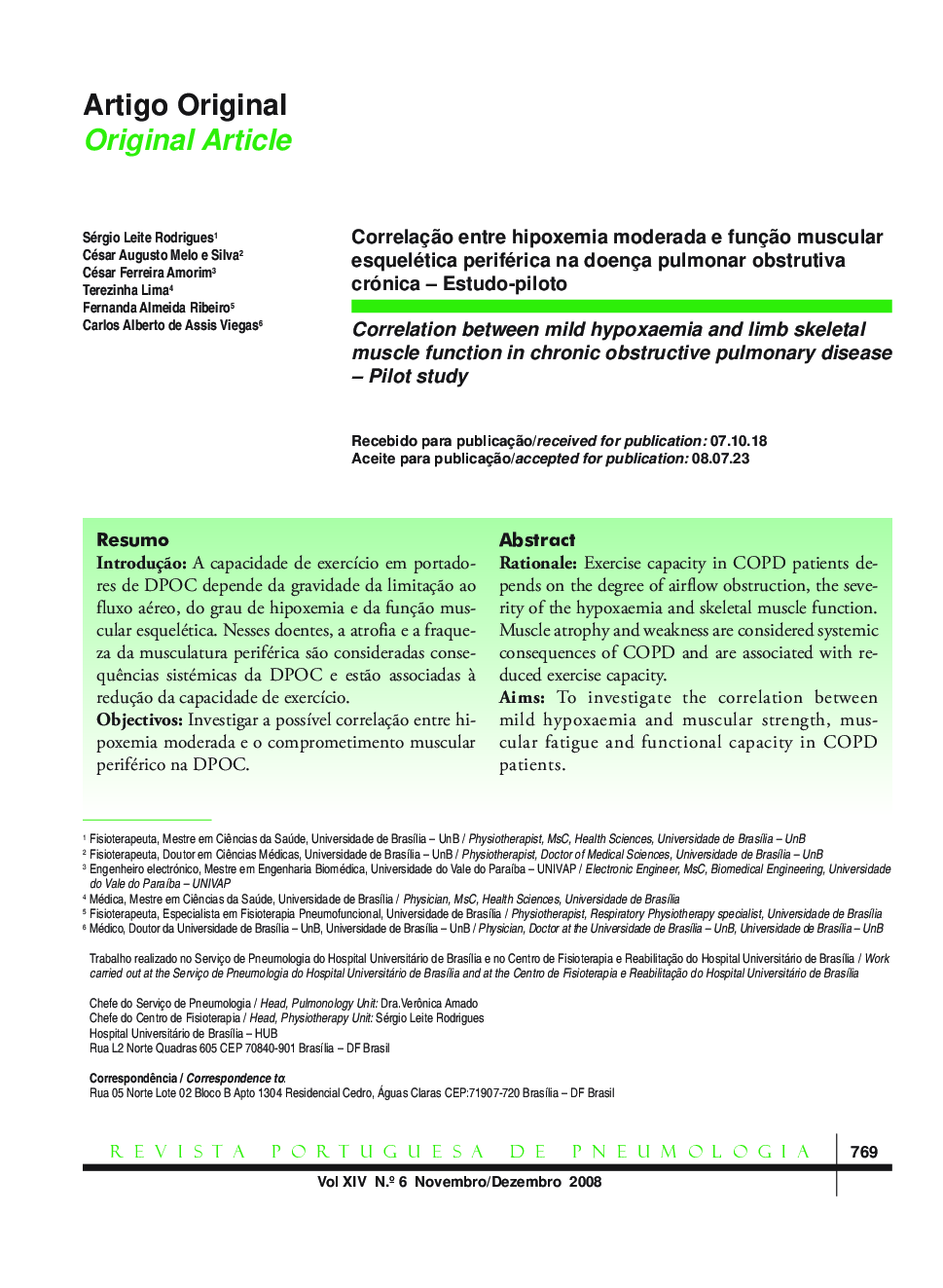| Article ID | Journal | Published Year | Pages | File Type |
|---|---|---|---|---|
| 4214876 | Revista Portuguesa de Pneumologia (English Edition) | 2008 | 17 Pages |
RationaleExercise capacity in COPD patients depends on the degree of airflow obstruction, the severity of the hypoxaemia and skeletal muscle function. Muscle atrophy and weakness are considered systemic consequences of COPD and are associated with reduced exercise capacity.AimsTo investigate the correlation between mild hypoxaemia and muscular strength, muscular fatigue and functional capacity in COPD patients.MethodsTen patients enrolled on a PRP at the Hospital Universitário de Brasília – HUB were included in this study. Lung function was evaluated by spirometry and arterial blood gas analysis. Functional evaluation was made using the 6MWT and using isometric contraction of deltoid and quadriceps muscles.ResultsThere were positive correlations between PaO2, quadriceps strength (r2 = 0.61 and p = 0.007) and PaO2 and the 6MWT (r2 = 0.96, p = 0.001). There were negative correlations between PaO2 and median frequency of quadriceps (r2 = -0.42 and p = 0.04). We observed significant correlation between quadriceps strength and the 6MWT (r2 = 0.67 and p = 0.001). There was negative correlation between median frequency of quadriceps and the 6MWT (r2 = -0.42 and p = 0.04). We did not observe any correlation between PaO2 and strength or median frequency of deltoid muscle.ConclusionsPaO2 has important correlations with muscular function variables. The main negative impact of mild hypoxaemia and precocious limb muscular disability on COPD patients is decreased functional capacity.
ResumoIntroduçãoA capacidade de exercício em portadores de DPOC depende da gravidade da limitação ao fluxo aéreo, do grau de hipoxemia e da função muscular esquelética. Nesses doentes, a atrofia e a fraqueza da musculatura periférica são consideradas consequências sistémicas da DPOC e estão associadas à redução da capacidade de exercício.ObjectivosInvestigar a possível correlação entre hipoxemia moderada e o comprometimento muscular periférico na DPOC.Doentes e métodosDez doentes encaminhados ao Programa de Reabilitação Pulmonar do Hospital Universitário de Brasília foram incluídos neste estudo. A função pulmonar foi avaliada por espirometria, gasometria arterial e avaliação funcional pelo teste de caminhada de seis minutos, sinal electromiográfico e força de deltóide e quadricípetes.ResultadosAs correlações entre PaO2 e a força quadricíptica (r2 = 0,61 e p = 0,007) e a distância percorrida no TC6 (r2 = 0,96 e p = 0,001) foram positivas e significativas. Houve correlação negativa e significativa entre PaO2 e a frequência mediana de quadricípetes (r2 = -0,42 e p = 0,04). Observámos também correlação significativa entre força de quadricípetes e o TC6 (r2 = 0,67 e p = 0,001). Assim como houve correlação negativa e significativa entre a frequência mediana de quadricípetes, e o TC6 (r2 = -0,42 e p = 0,04). Não encontrámos correlação significativa entre a PaO2 e força ou frequência mediana do músculo deltóide.ConclusãoA PaO2 tem correlação importante e significativa com variáveis de função muscular periférica. A hipoxemia moderada e a disfunção muscular periférica precoce possuem como principal impacto negativo a deterioração da capacidade funcional de portadores de DPOC.
